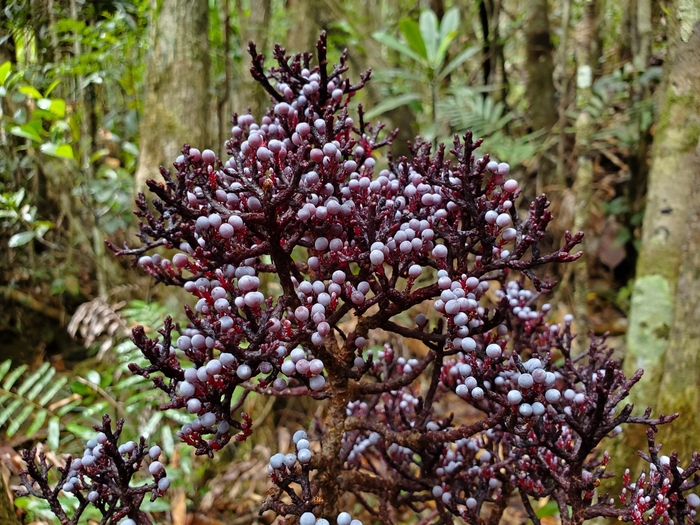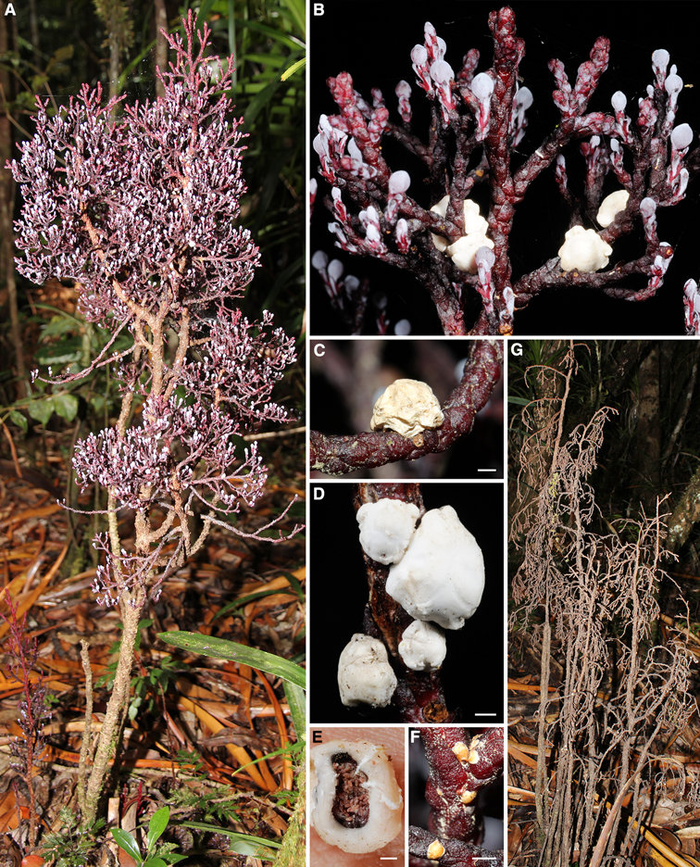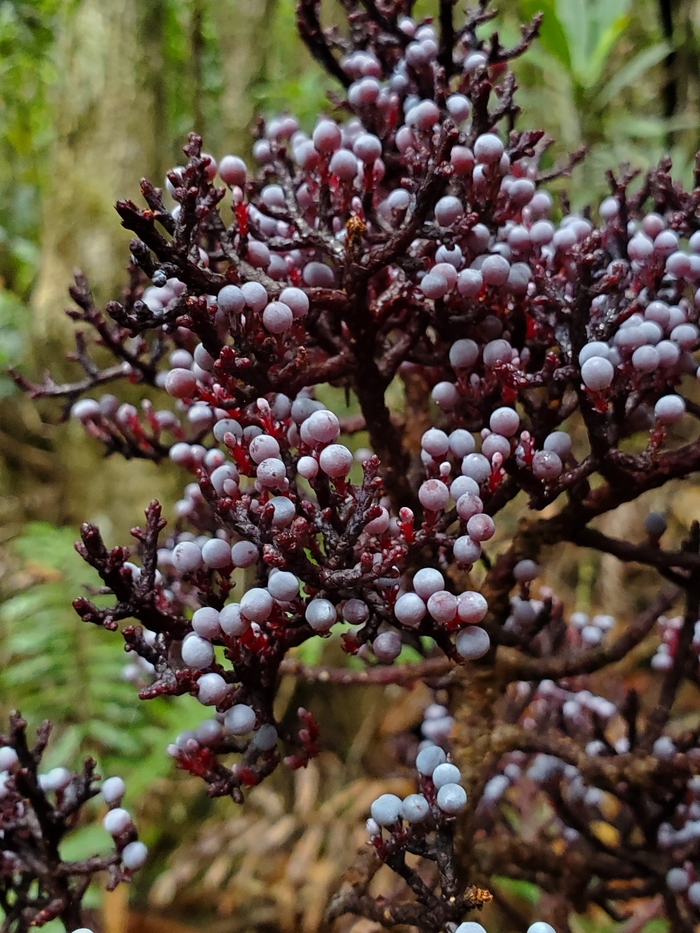Parasitaxus usta, also known in French as cèdre rabougri, is a rare and fascinating species of conifer that is native to the remote forests of New Caledonia. Belonging to the Podocarpaceae family, it is the only species in the genus Parasitaxus, making it a unique entity in the world of botany. Known for its unusual parasitic lifestyle, Parasitaxus usta has intrigued scientists and naturalists alike, offering valuable insights into plant evolution, parasitism, and symbiosis.

Parasitaxus usta is a small, woody shrub that typically reaches a height of up to 1.8 meters. Despite its modest size, it stands out due to its parasitic relationship with other plants, specifically the conifer Falcatifolium taxoides, commonly known as Falcatifolium or bent-leaved podocarp. This species exhibits a striking appearance with its greyish-white cones, which are a notable feature of the plant.
One of the most intriguing aspects of Parasitaxus usta is its lack of roots. Unlike most conifers, which have a robust root system for nutrient and water absorption, Parasitaxus usta lacks its own roots entirely. Instead, it attaches itself to the roots of Falcatifolium taxoides or other host plants to extract essential nutrients. This parasitic relationship is a defining characteristic of Parasitaxus usta, as it cannot survive independently in the wild.
Parasitaxus usta is often referred to as the "only known parasitic gymnosperm", making it a significant subject of study in the field of plant parasitism. Unlike the majority of parasitic plants, which are angiosperms (flowering plants), Parasitaxus usta belongs to the gymnosperms group, a class of non-flowering seed plants. Its parasitic nature is particularly unique because it lacks the typical root structures that would allow it to absorb nutrients directly from the soil. Instead, it depends entirely on its host, typically Falcatifolium taxoides, to supply it with the necessary resources for survival.
While the plant has high levels of chlorophyll, its ability to photosynthesize is limited. Molecular genetic studies have shown that the plastid genome of Parasitaxus usta is missing many essential photosynthetic genes, which strongly suggests that it relies almost entirely on its host plant for nutrition. Interestingly, approximately 60% of the genes typically associated with photosynthesis are either completely absent or present only in fragmentary forms in its genome, further underscoring its dependence on its host.

The taxonomy of Parasitaxus usta has been a subject of intense interest in the field of botany. Molecular phylogenetic analyses indicate that Parasitaxus usta shares a close evolutionary relationship with other genera within the Podocarpaceae family, such as Manoao from New Zealand and Lagarostrobos from Tasmania. This suggests a complex evolutionary history involving both parasitism and symbiosis, which may have evolved over millions of years.
The plant was first described by the French botanist Vieillard in 1861 and was later recognized as a parasitic plant in 1959. The species' scientific name, Parasitaxus usta, derives from the Latin word "usta," meaning "dried" or "withered," referencing its unique and somewhat lifeless appearance due to its parasitic lifestyle.
Parasitaxus usta is endemic to the forests of New Caledonia, which are considered a biodiversity hotspot. The plant is relatively rare and has been classified as vulnerable by conservationists due to its limited distribution and the specific environmental conditions required for its survival. The destruction of its natural habitat, primarily driven by logging and land development, poses a significant threat to the species' survival.
Efforts to conserve Parasitaxus usta include habitat preservation and the protection of its host plants, such as Falcatifolium taxoides, which are also at risk due to deforestation. Protecting the delicate ecological balance between Parasitaxus usta and its host plants is crucial for ensuring the survival of this unique species.

While Parasitaxus usta does not have known commercial or medicinal uses, its unusual parasitic behavior has made it a subject of significant interest for scientific research. The plant's ability to thrive without photosynthesis offers insights into plant evolution, parasitism, and the genetics of non-photosynthetic life forms. Research on this species could pave the way for a deeper understanding of plant parasitism and could potentially lead to discoveries in fields such as genetics, plant pathology, and even biotechnology.
Additionally, Parasitaxus usta serves as a natural example of how some plants have adapted to life in extreme conditions. Its study could inspire innovations in sustainable agricultural practices or help in the development of more resilient plant species capable of surviving in nutrient-poor soils.
Parasitaxus usta, the parasitic conifer of New Caledonia, is a remarkable species that challenges our understanding of plant biology. With its unique parasitic lifestyle, dependence on host plants, and evolutionary significance, it continues to captivate the scientific community. While its conservation remains a critical issue, ongoing research into its ecological and genetic makeup could offer valuable insights into the broader dynamics of plant parasitism and symbiosis. As a living relic of evolutionary history, Parasitaxus usta not only contributes to our understanding of biodiversity but also highlights the intricate relationships that sustain life on Earth.
Nickrent, D. L. (2006). Parasitaxus usta: The Only Known Parasitic Gymnosperm. Journal of Plant Research, 119(3), 295-302.
De Laubenfels, D. J. (1978). The Podocarpaceae of New Caledonia. New Zealand Journal of Botany, 16(1), 65-72.
Barrett, J. (2013). The Evolutionary Origins of Parasitic Plants. Plant Biology, 15(6), 807-814.
Laffan, S. W. et al. (2009). The Genomic Basis of Parasitism in Plants. Molecular Plant Pathology, 10(4), 453-468.
animal tags: Podocarpaceae
We created this article in conjunction with AI technology, then made sure it was fact-checked and edited by a Animals Top editor.